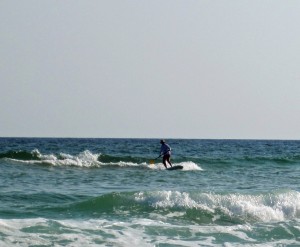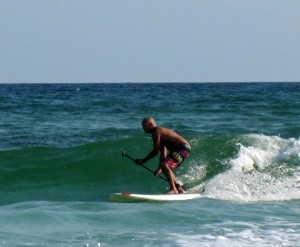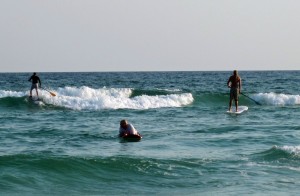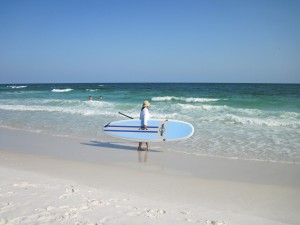You’ve probably noticed them out at the beach, bay, lake or river and wondered what’s the deal with the paddle and the surf board? Well, it’s not actually a surf board but a stand-up paddle board, or SUP as it’s also known; a wider and more stable version of an old classic that’s opening up new windows of opportunity for surfers, fisherman and recreational paddlers everywhere.
Believed to have evolved from the Polynesian islands in the early fifties, stand-up paddle boards started gaining modern attention again in the last decade when surfers in Hawaii and the west coast began embracing the longer paddle to help them maintain better control of a wave and to catch more sets. Not to be left out, recreational paddlers soon adopted the sport for a variety of activities including competitive racing and fishing.
Stand-up paddle boards are light and easy to transport making them a perfect choice for those not wanting the hassle of hauling around the heavier kayaks and canoes. Their size also makes them the perfect vehicle for getting into those places that are too shallow for regular kayaks or canoes to venture into. As an added bonus SUPs are stable enough to carry gear and a small passenger such as a child or pet.
SUP for Your Health
Paddle boarding is not as easy as the professionals make it look, in fact, it may take a bit of practice to stay up on the board the first few times you head out. That’s okay though because SUPing provides a great upper body workout as well as improves balance. Practice is the key to this mastering this fun sport, and once the balancing part has been mastered there are plenty of ways to keep challenging yourself.
The seemingly over-long paddle, the key element of paddle boarding, not only allows the paddler to perform turns, but it helps to power through waves and adds stability and maneuverability to wave riding. Paddle boarding is a full body workout that works your legs, core, and arms. SUPing is a great sport to get involved in and also provides a fun way to stay healthy.
Selecting a Standup Paddle Board
Beginners would do good to rent a board or try one for free at a local paddle board demo before rushing out to buy one of their own. Paddling lessons is another good way to get some experience on a board before that final purchase. Entry level boards range anywhere from $600-$1000 dollars. A good way to save money is to check the sales papers for used boards being sold by paddlers that are upgrading to newer boards.
A wide board provides better stability and is great for beginners. A deck grip is also beneficial in helping new paddle boarders find and keep their footing as they’re learning. As you get more comfortable with paddle boarding you might want to consider trading up to a faster or narrower board, especially if racing or surfing appeals to you. Why not find a paddle board dealer in your area and see what it’s all about?
[amazon_enhanced asin=”B001O9J8HW” /]




